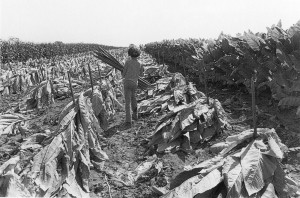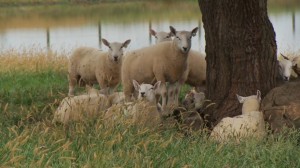By Kakie Urch
As the new documentary “Coming To Ground” – debuting regionally on KET on Earth Day — points out, Kentucky isn’t exactly known for being an innovator in policy.
After all, the “A woman may not purchase a hat without her husband’s permission” law remained on the books for decades after women stopped wearing hats. And gloves, for that matter. Oh, let’s face it, it’s probably still on the books.
But in tobacco, Kentucky has always led the way. And so we have again, with a fairly obscure piece of legislation called House Bill 611, passed in 2000.
It has changed your life, but you probably don’t know it.

“Coming to Ground” documents the way that the bill, in a decade, has turned the state’s tobacco crop into the thriving “Kentucky Proud,” sustainable, farm-to-table, forage forward agricultural diversity we see at the state’s farmers markets, in the cities’ best restaurants and even in the dining halls of the University of Kentucky dorms. And it shows Kentucky serving as a policy model, a leader.
Produced and directed by Kentucky natives Fred Johnson and Jean Donohue, “Coming to Ground” shows viewers, through interviews with farmers themselves, how when it came time to strip tobacco from the state’s agricultural base, Kentucky crafted, almost by accident, a policy and practice of agricultural transition that is now a model.
The documentary, about 2.5 years in the making, connects the dots, for those who don’t have their eyes constantly trained on Frankfort, between some of the real agricultural and cultural successes in a post-tobacco Kentucky.
The idea for “Coming To Ground” all started in that place where many Ace readers spend their Saturday morning each week: The Lexington Farmers Market.
Donohue said, “Fred and I were moving out of Boston and we came down to Lexington and we started going to the farmer’s market and we just started looking around and noticing that there was something really extraordinary going on there. Then we started looking at what the restaurants were doing. When we left Lexington, the market was kind of like a little nice thing but when we came back there were so many people, so many farmers, so much diversity. We though ‘Goodness, what is happening here?’
The five vegetable trucks and a gladiola vendor lined up along Vine Street every Saturday when they left town had turned into a bustling market packed with customers and scores of vendors.
“Given all the other films that are out there (about food and sustainable agriculture) we didn’t think that people were connecting the dots between agricultural policy and what is happening with farmer’s markets,” she said.
“We spent a couple of months developing a proposal. There was a story moving subterraneously through Kentucky…we just started digging into that story and found HB 611,” she said.
“Ultimately we just wanted people to understand with all the slow food things happening to understand what the underpinning was, and that it could happen in other states,” Donohue said.
“We’d spent six years in Boston and sat soundly through a number of academic conversations and personal ones where the smugness about the red states was just amazing,” Johnson said.
“What we were excited about was to say that there is this wonderful local food movement and here’s an example from the little ol’ red state and we’d like to jam this back in the public’s face,” he said.
***
Kentucky is No. 2 in the nation in family farms per capita. It is No. 4 in the nation in the sheer number of family farms overall. And so, many of those farms, from the 1930s forward, banked, and thrived, planned and sent kids to college on the golden leaf and the federal tobacco support program. In the 1980s and 90s, many of my UK students told me they were in my classes only because their parents were “using the base for tuition.”
And in a state where traffic was routinely slowed by flatbeds stacked with leaf to market, where little brothers earned their used pickups (and their raw, bloody, tar-streaked hands) stripping and cutting plants, where every barn you passed had openings spilling forth the drying sienna plant, where high schools excused kids from class for weeks at a time with the rhythm of the tobacco season and in 1982, the lecture halls at University of Kentucky still had ashtrays on the backs of the classroom seats, no one had to ask what the base was.

The decision in Frankfort to turn a full 50 percent of the billions allocated to the state in the tobacco buyout following the federal lawsuit against the tobacco industry was unique amongst the 14 states that received funds from the Master Settlement Agreement and the National Tobacco Buyout. HB 611 laid out the terms by which tobacco farmers would be helped to shift their world entirely.
With House Bill 611, The Tobacco Buyout became The Kentucky Farm Buy In. It meant that for Kentucky, 50 percent of the $3.5 billion over a 25-year period would go to diversified and sustainable Kentucky crops. The total value federally was $206 billion over 25 years, a result of the largest corporate settlement in history.
***

Like all good documentaries, “Coming to Ground” puts policy and development in time context – and in human context. It shows us Kentuckians, from Berea to Jessamine County to Western Kentucky, who redeveloped their tobacco farms and used the guidance and funding from the tobacco buyout to switch to crops that now sustain and repair the land – and pay their bills.
Elmwood Stock Farm, a major organics supplier at the Lexington Farmer’s Market and a farm with an innovative farm share program for urban customers is featured. Farmers talk about how they had to learn their land again and now raise crops or herds that are suited to Kentucky’s land and popular at market. BlueGrass Chevre goat dairy is featured. A Jessamine farm that went from a huge tobacco base to a beef cattle operation is included. The farmers themselves, from many backgrounds and many generations, describe how the decade has treated them and their land.
Half, at least, of the farmers interviewed, in “Coming to Ground” are women. And that is intentional, Donohue said. “I believe that women are the face of the new agrarianism. I think women are coming back to it big time and that it does reflect a trend. “
The people featured in “Coming to Ground” are also those who fought in Frankfort, as a unified front across usually divided counties, agricultural agencies and government groups to put the funds to use in reinvestment and innovation.
It also features those who took that investment and turned it into wildflowers, beef, heirloom seed and vegetables, goat cheese, vineyards, organic vegetables and local eggs. Instead of turning the tobacco buyout money over to county judge-executives (as dramatized in high caricature by Boss Hogg), the groups argued, it should go to the farmers themselves, through a new commission that had a plan for new crops, sustainability, marketing and agricultural innovation.
The fighting was bitter, we see, through archival legislature video and newspaper clippings, and Kentucky was striking out alone – as other states funneled the money to their deficits, anti-smoking advertising campaigns and other non-farm uses.
People in “Coming To Ground” include: Charles and Mary Berry Smith, John-Mark Hack, agricultural advisor to Gov. Patton; Roger Thomas, director of the Governor’s Office of Agricultural Policy; First Lady Jane Beshear; Martin Richards, director of the Community Farm Alliance; Wes Jackson, plant geneticist and author of “Consulting the Genius of Place; farmers, Bill Best, John and Randy Seymour, Ann Bell Stone, Janey Norton Newton, Laura Riccardi Lyvers, Sam Moore, Susan Miller, Charles Miller, among others.
***
The filmmakers, who are life partners in addition to creative partners, have been together for 30 years. They like to say they have “Dual citizenship in Kentucky and Oregon.” They currently live in Portland and are doing another environmental film project. Both come from Kentucky families with farm backgrounds, with his people from Greenup and hers from Hart County near Horse Cave.
Donohue is president of the Media Working Group and Johnson is vice-president. Their work has appeared on Discovery, BBC, WNET, KET and many other networks. Their most recent work is “The Gender Chip Project,” which outlines the challenges facing girls and women who enter science, engineering and mathematics. Their film “Coal Black Voices” is about the Affrilachian poets group founded in Lexington by Frank X. Walker, National Book Award winner Nikky Finney and others.
“Coming To Ground” is partially grant-funded. “We got a major grant from the Kentucky Agricultural Devlopment Fund, and others from the Kentucky Humanities Council, Ohio Arts Council, Google Earth, and we are still fundraising. We used some our own money too,” they said. The project cost $155,000 -$200,000, they estimated.
Did the Kentucky Agricultural Development Fund, which is one of the parties to the distribution of the tobacco settlement money, get a cut approval on the project? No, the filmmakers said, but there was an agreement, through the proposal process about the approach the film would take.
“I think it’s important for filmmakers to work with government again like the way we used to do in the 1930s with the WPA. The state of documentary film in this country is such that we cannot ignore government support,” Jean said.
“We did not set out to make an expose or an investigative journalism approach. We know enough of the history of it now to know that that type of story is probably there. Our goal was to tell the story of what happened, to tell the story of these farmers through outcomes….tell that story, celebrate Kentucky’s role in it and connect that to actual farm practices and people,” she said.
And if the film is about Kentucky tobacco and farming, why does the introductory section take a wider lens? Why, for example, is there an footage of a collapsing iceberg? That was also intentional.
“We spend time on the global section for the following reasons. We just don’t want to make a film about agriculture that doesn’t scare the shit out of people at the front end. We are in a very strange time for our whole global food system, “ Johnson said.
“We think that the kind of changes that are going to have to happen to the system ….that the kind of ominous section there at the beginning outlines the need for are going to be of a big nature — like the tobacco settlement.”
There is a lot of “vegetable porn”….celebrating local food. But most of those films don’t talk about what the role of government is. They talk about bad government policy but they don’t talk about good government policy. It is more than wealthy hippies going out on the land and growing organic food, though that is one good step. A truly sustainable farming policy has to be large scale. We are facing vast global problems. Large scale solutions are going to involve government,” Johnson said.
“We think that the tobacco settlement program is an example of the types of changes that are going to have to happen, “Donohue said.
“There are a lot of people who are into food who don’t want to think about government. They are very libertarian,” Johnson said. But, he stressed, in order to tackle something the size of food conglomerates, something of an equal weight – perhaps government – must be involved.
The documentarians found a few surprises as they went to learn in-depth about the state’s agricultural changes.
“One of the things that surprised me was crop diversity. One of the major underpinning goals in terms of HB 611 and the policy shift that it all represents was to diversify agriculture. There were two things that I was surprised by one was that the diversity of crops could be and was very complementary with the notion of sustainability in moving away from monocrops” Fred said.
“The other one you know, is that Kentucky is a forage state. ( Where grasses allow animals to forage, making it a great place to grow cattle.) Wendell Berry says that that landscape needs cattle on it. It’s a great place to grow cattle and it’s a great place to grow meat. Meat is back …a lot of people are starting to eat meat if they know where it came from. I was amazed that Kentucky was a uniquely good place to grow that kind of meat,” he said.
Fred also noted the $25 million the Ag Development Fund has put into farmland preservation as one of the cornerstornes of sustainable, healing policy. It’s not adequately treated in the film, but it is very important he said.
Donohue was impressed with “how much money they are putting into environmental development…. water……restoring pond water, erosion, critical stuff that is not very sexy and it’s also hard to photograph, but really extraordinary,” she said.
 What the documentary does photograph, and beautifully, is Kentucky as we know it, as we see it, side of the road every day. Those outside the state may think the cinematography is some kind of regional, soft-lens, landscape porn with Hollywood production values. The fact is: Kentucky and her farms and farmers are really that beautiful. It’s a documentary.
What the documentary does photograph, and beautifully, is Kentucky as we know it, as we see it, side of the road every day. Those outside the state may think the cinematography is some kind of regional, soft-lens, landscape porn with Hollywood production values. The fact is: Kentucky and her farms and farmers are really that beautiful. It’s a documentary.
That is what this film, (and apparently, House Bill 611, too) is all about.
Air Times for “Coming To Ground” on Kentucky Educational Television:
KET: Sunday, April 22 at 2:00 pm EDT
KETKY: Sunday, April 22 at 7:00 pm EDT
KETKY: Monday, April 23 at 8:30 pm EDT
KETKY: Tuesday, April 24 at 8:30 am EDT
KET2: Tuesday, April 24 at 9:00 pm EDT
KET: Wednesday, April 25 at 3:00 am EDT
KETKY: Friday, April 27 at 2:30 pm EDT
KETKY: Saturday, April 28 at 9:00 am EDT
Kakie Urch is an Asst. Professor of Multimedia in the School of Journalism and Telecommunications at the University of Kentucky. As an editor at the Kentucky Enquirer and Kentucky Post during the 1990s and 2000s, she supervised coverage of the passage of HB 611 and the adoption of many of the tobacco settlement innovation measures featured in “Coming To Ground.” She also annually supervised the coverage of the Garrard County Tobacco Cutting Contest in which farmers, for the last 30 years, have vied for the championship prize for cutting an entire row the fastest.
YOU MIGHT ALSO LIKE
Ace 2010, Know Your Farmer, Know Your Food, Know Your Politics
Ace 2007 coverstory, Barbara Kingsolver, Animal Vegetable Miracle [pdf]
Ace 2004 coverstory, Walter Brock documentary, LAND
Ace 2003, Slow Food in Kentucky
Ace 2002, Kentucky’s Family Farm: Old and New Agrarianism
Ace 2001 coverstory, An Open Letter from Barbara Kingsolver








